| |
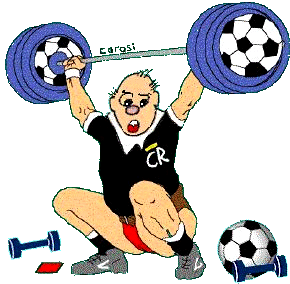 |
PREPARING TO EXERCISE
Preparing and Training…
Andrew Castiglione
Founder of Ken Aston Referee Society
 |
1. GENERAL WARM UP
2. S T R E T C H I N G
3. SPECIFIC WARM UP |
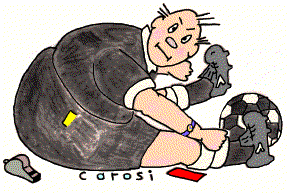 |
THE IMPORTANCE OF WARMING UP
Warming your body up is an essential part of pre-match preparation and
training as it prepares your body for action and improves your
performance.
Thought - The first minute is as important as the
ninetieth minute.
Warming up will:
 - Gradually increase your heart rate
- Gradually increase your heart rate
 - Increase the flexibility of your muscles, tendons and ligaments
- Increase the flexibility of your muscles, tendons and ligaments
 - Improve speed
- Improve speed
 - Promote faster reactions
- Promote faster reactions
 - Increase range of movement
- Increase range of movement
 - Reduce risk of injury
- Reduce risk of injury
There are three phases to warming up.
1. GENERAL WARM UP
The warm up should begin with exercises involving your whole body, and
should last for about 5-10 minutes, depending on the temperature. The
aim of this phase is to:
 - Raise the temperature of your body
- Raise the temperature of your body
 - Raise the temperature of your muscles
- Raise the temperature of your muscles
 - Increase the amount of blood flowing to your muscles
- Increase the amount of blood flowing to your muscles
Start off with light jogging (e.g. 2 or 3 slow laps of the pitch) and
include some skipping, backwards and sideways running and some arm
circling to warm your upper body.
- You should be sweating
lightly at the end of this phase and your pulse rate should have risen
to about 120 beats per minute before moving onto the next phase.
2. STRETCHING
You should stretch those parts of your body that will be used during
your match or training session.
- Hold each
stretch for 10 seconds at the point of slight discomfort... relax - then
repeat 2 or 3 times.
- Never stretch cold
muscles. DON'T BOUNCE.
Include the following stretches in your warm up.
 |
ACHILLES STRETCH
Stand with one leg forward of the other, feet pointing forwards,
back heel on the ground with the back leg slightly bent.
Keeping your back straight and your back heel on the ground -
sit back until you can feel a stretch low down near your
Achilles tendon. |
CALF STRETCH
Stand with one leg forward of the other - slightly more than in
the previous exercise - feet pointing forwards, back heel on the
ground and the back leg straight.
Keeping your back straight and your back heel on the ground bend
your front knee and move your weight forward and down until you
can feel the stretch on the back of your calf. |
 |
 |
QUADRICEPS
STRETCH
(front of thigh)
Hold your foot with your hand and lift your foot up behind your
buttock.
Pull the foot back and away from the buttocks and push the knee
towards the ground.
Use a wall or a partner if balance is a problem. |
HAMSTRING STRETCH
(back of thigh)
Stand with one leg forward of the other, feet pointing forwards.
Push the hips back, bend your back leg slightly to support your
weight, hands on supporting knee, and then straighten your front
leg. Increase the stretch by pushing your hips back and down.
For a further stretch pull your toes up.
Alternatively - you can sit down with your legs straight and
grasp your toes and pull them towards you. Both these stretches
are a far safer alternative to the ‘touch your toes' stretch.
Warning - Stretches which involve dropping down to touch the toes are not recommended. |
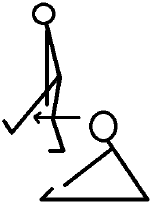 |
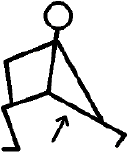 |
GROIN STRETCH
Stand with your feet about 1 meter apart. Keeping your right leg
straight, bend your left knee and lean your upper body towards
the outstretched leg until you feel the stretch on the inside of
your right thigh. |
SIDE STRETCH
Stand with your feet wide apart and your hands down by your
sides.
Lean to one side, reaching down with the hand to the knee.
For an extra stretch bring the other arm over the top of the
head.
Warning - Do not bend forward or backward during this stretch
and don't over-stretch. |
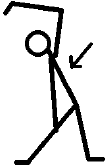 |
 |
SHOULDER AND
TRUNK STRETCH
Place your left hand on the back of the right shoulder and take
the right arm back behind. Keep the hips facing forward and
twist the shoulders and head around to the right, stretching the
back of the left shoulder, the chest and front of the right
shoulder, the trunk and the neck. |
3. SPECIFIC WARM UP
In this phase, which should last for about 5 minutes, the aim is to get
ready for the task ahead by performing exercises that are directly
related to the effort to be made, be it a match, training, or taking a
test.
You should include:
 - Bursts of shorter, faster runs (i.e. Running at match speed)
- Bursts of shorter, faster runs (i.e. Running at match speed)
 - Twists and changes in direction
- Twists and changes in direction
 - Short sprints
- Short sprints
- At the end of a warm up
you should feel warm rather than hot and be slightly out of breath.
If your warm up is in preparation for a match you should aim to complete
warming up 10 – 15 minutes prior to the start of the game. Return to the
dressing room and keep warm.
If you are warming up to train then off you go.
THEORY vs REALITY
All this is fine for those of you Refereeing in higher levels of
football where there are facilities and the opportunity to warm up
properly. But what about local football? What if you do not have a
dressing room to return to, or if you do, it is a bus ride away?
Thought –
 - Warming up is important at all levels.
- Warming up is important at all levels.
 - The first minute is as important as the ninetieth in all games.
- The first minute is as important as the ninetieth in all games.
 - Injuries can occur in any match.
- Injuries can occur in any match.
Advice –
 - Before putting on your boots, run on the spot for 2-3 minutes varying
your pace every now and again.
- Before putting on your boots, run on the spot for 2-3 minutes varying
your pace every now and again.
 - Perform the stretching exercises.
- Perform the stretching exercises.
 - Put your boots on, and run onto the center of the field of play.
- Put your boots on, and run onto the center of the field of play.
 - Run to one of the goals to check the nets and...
- Run to one of the goals to check the nets and...
 - Then run to the other end including changes in speed and direction as you go.
- Then run to the other end including changes in speed and direction as you go.
 - Check the nets and run back to the center circle.
- Check the nets and run back to the center circle.
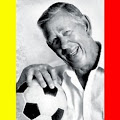 This Video from the... Ken Aston Referee Society -
This Video from the... Ken Aston Referee Society -
 Channel Channel

THE IMPORTANCE OF THE WARM
DOWN
The "Warm Down" is very much
neglected, but it is just as important as the "Warm
Up" and should be performed after every training session and
match.
- The "Warm
Down" is aimed at gradually returning the body to its resting
state.
- At the very least,
on returning to the dressing room or on the completion of your training,
you should repeat the stretching exercises performed as part of the warm
up. This helps to prevent muscle stiffness and the onset of muscle
soreness that can follow a particularly hard match or training session.
Source of information: 'A Guide to
Fitness for Referees' April 2001, produced by the Football Association
England. Acknowledgement to the National Coordinator for Fitness
Training, Vernon Crew; along with expert advice from John Brewer,
Director of the Lilleshall Sports Injury and Human Performance Center;
Alan Hodson, Director of the Football Association Medical Education
Center; and Rob Hartley, Head of the Sports Science Department,
University of Brighton.
|